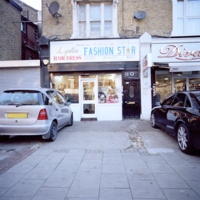
Lydia's 2 Light
Letitia Kamayi: You Should Know Me
Artist’s Statement Kongo: You Should Know Me was my selfish way of learning more about my past, my ancestors through the images of my kinfolk. Unfortunately, the archive institutions I approached all asked for paperwork I could not supply; money I could not pay and questions I did not understand how to answer.
Only one missionary based in Ghent; the Sisters of Charity of Jesus and Mary, opened its doors and visual records to me and through them I was able to see a small percentage of the Congolese story before me. Though happy to have this access, I was not too overjoyed by everything I saw. There was a host of missing stories not recorded, stories that my family and friends families experienced. Chapters and verses missing from the identity of the Congolese narrative. Thus Kongo: You Should Know Me evolved to Kongo Archives.
Kongo Archives is extremely personal to me not merely because I am Congolese but also because there is a lot about my country I do not know and am searching for. I believe it is also something desperately needed, especially as our country’s political structure hangs in the global balance.
It’s a necessity even!
Culture; traditions; customs; language and pretty much everything has always been passed down orally through the stories in African customs, and now too many of those who did the passing down are fast passing away, taking with them all our history and rightful heritage. Taking away my rightful heritage, my story, my future and connection to a national identity.
It is a cliché to say, however Kongo Archives gives a voice to every Congolese person, travelling further than just those within the confines of the project. The archives is the stories of the past, the present and a storage unit where future stories can be placed when they become part of our inevitable past.
It [Kongo Archives] is here to topple the power structures of the single story of Congolese identity, working to reform the world’s understanding of, and have embedded notions questioned of a people whose stories and lives were second to the arrival of their colonial history and identity killers.
Bringing light to the stories which humanise the “so-called beasts from the dark continent” which continues till this day to suffer from decades of war and conflict whilst also being the wealthiest in natural minerals; culture and fight for peace one day.
Being Congolese I see our hidden presence in the “strangest” places, though this should not be a “strange” sight, this is the importance which representation brings! Change to people’s (and my own) opinions and views of those they are not well informed about. Kongo Archives will bring light to the multilayers of the Congolese people both residing in and out of The Motherland. It is important to have this representation to solidify the very absent Congolese presence outside of the Democratic Republic of Congo, in places such as London; Paris and Belgium as a positive display of unity; positive contribution and patriotism.
Kongo Archives aims to bring the Congolese heritage full circle through exposing the parts of our (Congolese) past and current state the world has and continues to fail to reveal. Breaking down the stereotypes of the poorest; “most dangerous place on earth to be a woman” to a country with a vast potential of peace; unconditional source of love and fight given the chance for change within its power structures.
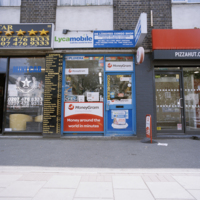
De Londres
Letitia Kamayi: You Should Know Me
Artist’s Statement Kongo: You Should Know Me was my selfish way of learning more about my past, my ancestors through the images of my kinfolk. Unfortunately, the archive institutions I approached all asked for paperwork I could not supply; money I could not pay and questions I did not understand how to answer.
Only one missionary based in Ghent; the Sisters of Charity of Jesus and Mary, opened its doors and visual records to me and through them I was able to see a small percentage of the Congolese story before me. Though happy to have this access, I was not too overjoyed by everything I saw. There was a host of missing stories not recorded, stories that my family and friends families experienced. Chapters and verses missing from the identity of the Congolese narrative. Thus Kongo: You Should Know Me evolved to Kongo Archives.
Kongo Archives is extremely personal to me not merely because I am Congolese but also because there is a lot about my country I do not know and am searching for. I believe it is also something desperately needed, especially as our country’s political structure hangs in the global balance.
It’s a necessity even!
Culture; traditions; customs; language and pretty much everything has always been passed down orally through the stories in African customs, and now too many of those who did the passing down are fast passing away, taking with them all our history and rightful heritage. Taking away my rightful heritage, my story, my future and connection to a national identity.
It is a cliché to say, however Kongo Archives gives a voice to every Congolese person, travelling further than just those within the confines of the project. The archives is the stories of the past, the present and a storage unit where future stories can be placed when they become part of our inevitable past.
It [Kongo Archives] is here to topple the power structures of the single story of Congolese identity, working to reform the world’s understanding of, and have embedded notions questioned of a people whose stories and lives were second to the arrival of their colonial history and identity killers.
Bringing light to the stories which humanise the “so-called beasts from the dark continent” which continues till this day to suffer from decades of war and conflict whilst also being the wealthiest in natural minerals; culture and fight for peace one day.
Being Congolese I see our hidden presence in the “strangest” places, though this should not be a “strange” sight, this is the importance which representation brings! Change to people’s (and my own) opinions and views of those they are not well informed about. Kongo Archives will bring light to the multilayers of the Congolese people both residing in and out of The Motherland. It is important to have this representation to solidify the very absent Congolese presence outside of the Democratic Republic of Congo, in places such as London; Paris and Belgium as a positive display of unity; positive contribution and patriotism.
Kongo Archives aims to bring the Congolese heritage full circle through exposing the parts of our (Congolese) past and current state the world has and continues to fail to reveal. Breaking down the stereotypes of the poorest; “most dangerous place on earth to be a woman” to a country with a vast potential of peace; unconditional source of love and fight given the chance for change within its power structures.
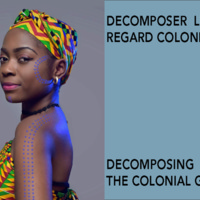
Decolonising the Colonial Gaze
Decolonising the Colonial Gaze
This collection documents the work of a community-based partnership between the Antislavery Usable Past project and Yole!Africa in Goma and Lubumbashi. The project is based on an archive of photography produced by the British missionary Alice Seeley Harris during her time in the Congo Free State in the late nineteenth and early twentieth century. The project has used the visual archive as a basis for working with young people to explore the history and legacies of colonialism during the time at which the Congo Free State was under the personal ownership of King Leopold II of Belgium.
Defining what the ‘antislavery usable past’ of these images is raises questions of power and representation. Who gets to decide? The writing of history is a powerful tool – who is included and excluded from the story, indeed, who gets to write it in the first place, is a reflection of the inequalities of the society within which that history is produced. Working with a colonial archive in Britain - a former centre of empire - raises issues about who gets to access history. For formerly colonised people their histories, or at least the portion of their histories relating to the colonial experience, are often found in the archives, museums, and art galleries of the former colonising power. Alice’s photographs, for example, eventually became part of the archive of the British and Foreign Antislavery Society, which subsequently became the present-day NGO Antislavery International. The archive is held at the Bodleian Library, University of Oxford. For people resident within the former spaces of empire, the physical impracticality of visiting the collection means a separation from the objects, documents, and images which represent their past.
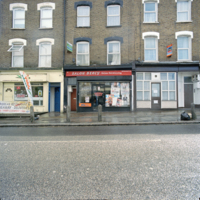
Bercy Salon
Letitia Kamaye: You Should Know Me
Artist’s Statement Kongo: You Should Know Me was my selfish way of learning more about my past, my ancestors through the images of my kinfolk. Unfortunately, the archive institutions I approached all asked for paperwork I could not supply; money I could not pay and questions I did not understand how to answer.
Only one missionary based in Ghent; the Sisters of Charity of Jesus and Mary, opened its doors and visual records to me and through them I was able to see a small percentage of the Congolese story before me. Though happy to have this access, I was not too overjoyed by everything I saw. There was a host of missing stories not recorded, stories that my family and friends families experienced. Chapters and verses missing from the identity of the Congolese narrative. Thus Kongo: You Should Know Me evolved to Kongo Archives.
Kongo Archives is extremely personal to me not merely because I am Congolese but also because there is a lot about my country I do not know and am searching for. I believe it is also something desperately needed, especially as our country’s political structure hangs in the global balance.
It’s a necessity even!
Culture; traditions; customs; language and pretty much everything has always been passed down orally through the stories in African customs, and now too many of those who did the passing down are fast passing away, taking with them all our history and rightful heritage. Taking away my rightful heritage, my story, my future and connection to a national identity.
It is a cliché to say, however Kongo Archives gives a voice to every Congolese person, travelling further than just those within the confines of the project. The archives is the stories of the past, the present and a storage unit where future stories can be placed when they become part of our inevitable past.
It [Kongo Archives] is here to topple the power structures of the single story of Congolese identity, working to reform the world’s understanding of, and have embedded notions questioned of a people whose stories and lives were second to the arrival of their colonial history and identity killers.
Bringing light to the stories which humanise the “so-called beasts from the dark continent” which continues till this day to suffer from decades of war and conflict whilst also being the wealthiest in natural minerals; culture and fight for peace one day.
Being Congolese I see our hidden presence in the “strangest” places, though this should not be a “strange” sight, this is the importance which representation brings! Change to people’s (and my own) opinions and views of those they are not well informed about. Kongo Archives will bring light to the multilayers of the Congolese people both residing in and out of The Motherland. It is important to have this representation to solidify the very absent Congolese presence outside of the Democratic Republic of Congo, in places such as London; Paris and Belgium as a positive display of unity; positive contribution and patriotism.
Kongo Archives aims to bring the Congolese heritage full circle through exposing the parts of our (Congolese) past and current state the world has and continues to fail to reveal. Breaking down the stereotypes of the poorest; “most dangerous place on earth to be a woman” to a country with a vast potential of peace; unconditional source of love and fight given the chance for change within its power structures.
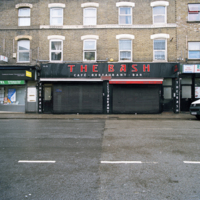
The Bash
Letitia Kamayi: You Should Know Me
Artist’s Statement Kongo: You Should Know Me was my selfish way of learning more about my past, my ancestors through the images of my kinfolk. Unfortunately, the archive institutions I approached all asked for paperwork I could not supply; money I could not pay and questions I did not understand how to answer.
Only one missionary based in Ghent; the Sisters of Charity of Jesus and Mary, opened its doors and visual records to me and through them I was able to see a small percentage of the Congolese story before me. Though happy to have this access, I was not too overjoyed by everything I saw. There was a host of missing stories not recorded, stories that my family and friends families experienced. Chapters and verses missing from the identity of the Congolese narrative. Thus Kongo: You Should Know Me evolved to Kongo Archives.
Kongo Archives is extremely personal to me not merely because I am Congolese but also because there is a lot about my country I do not know and am searching for. I believe it is also something desperately needed, especially as our country’s political structure hangs in the global balance.
It’s a necessity even!
Culture; traditions; customs; language and pretty much everything has always been passed down orally through the stories in African customs, and now too many of those who did the passing down are fast passing away, taking with them all our history and rightful heritage. Taking away my rightful heritage, my story, my future and connection to a national identity.
It is a cliché to say, however Kongo Archives gives a voice to every Congolese person, travelling further than just those within the confines of the project. The archives is the stories of the past, the present and a storage unit where future stories can be placed when they become part of our inevitable past.
It [Kongo Archives] is here to topple the power structures of the single story of Congolese identity, working to reform the world’s understanding of, and have embedded notions questioned of a people whose stories and lives were second to the arrival of their colonial history and identity killers.
Bringing light to the stories which humanise the “so-called beasts from the dark continent” which continues till this day to suffer from decades of war and conflict whilst also being the wealthiest in natural minerals; culture and fight for peace one day.
Being Congolese I see our hidden presence in the “strangest” places, though this should not be a “strange” sight, this is the importance which representation brings! Change to people’s (and my own) opinions and views of those they are not well informed about. Kongo Archives will bring light to the multilayers of the Congolese people both residing in and out of The Motherland. It is important to have this representation to solidify the very absent Congolese presence outside of the Democratic Republic of Congo, in places such as London; Paris and Belgium as a positive display of unity; positive contribution and patriotism.
Kongo Archives aims to bring the Congolese heritage full circle through exposing the parts of our (Congolese) past and current state the world has and continues to fail to reveal. Breaking down the stereotypes of the poorest; “most dangerous place on earth to be a woman” to a country with a vast potential of peace; unconditional source of love and fight given the chance for change within its power structures.
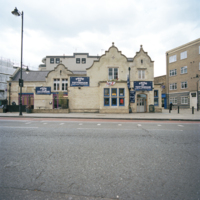
P.O.T
Letitia Kamayi: You Should Know Me
Artist’s Statement Kongo: You Should Know Me was my selfish way of learning more about my past, my ancestors through the images of my kinfolk. Unfortunately, the archive institutions I approached all asked for paperwork I could not supply; money I could not pay and questions I did not understand how to answer.
Only one missionary based in Ghent; the Sisters of Charity of Jesus and Mary, opened its doors and visual records to me and through them I was able to see a small percentage of the Congolese story before me. Though happy to have this access, I was not too overjoyed by everything I saw. There was a host of missing stories not recorded, stories that my family and friends families experienced. Chapters and verses missing from the identity of the Congolese narrative. Thus Kongo: You Should Know Me evolved to Kongo Archives.
Kongo Archives is extremely personal to me not merely because I am Congolese but also because there is a lot about my country I do not know and am searching for. I believe it is also something desperately needed, especially as our country’s political structure hangs in the global balance.
It’s a necessity even!
Culture; traditions; customs; language and pretty much everything has always been passed down orally through the stories in African customs, and now too many of those who did the passing down are fast passing away, taking with them all our history and rightful heritage. Taking away my rightful heritage, my story, my future and connection to a national identity.
It is a cliché to say, however Kongo Archives gives a voice to every Congolese person, travelling further than just those within the confines of the project. The archives is the stories of the past, the present and a storage unit where future stories can be placed when they become part of our inevitable past.
It [Kongo Archives] is here to topple the power structures of the single story of Congolese identity, working to reform the world’s understanding of, and have embedded notions questioned of a people whose stories and lives were second to the arrival of their colonial history and identity killers.
Bringing light to the stories which humanise the “so-called beasts from the dark continent” which continues till this day to suffer from decades of war and conflict whilst also being the wealthiest in natural minerals; culture and fight for peace one day.
Being Congolese I see our hidden presence in the “strangest” places, though this should not be a “strange” sight, this is the importance which representation brings! Change to people’s (and my own) opinions and views of those they are not well informed about. Kongo Archives will bring light to the multilayers of the Congolese people both residing in and out of The Motherland. It is important to have this representation to solidify the very absent Congolese presence outside of the Democratic Republic of Congo, in places such as London; Paris and Belgium as a positive display of unity; positive contribution and patriotism.
Kongo Archives aims to bring the Congolese heritage full circle through exposing the parts of our (Congolese) past and current state the world has and continues to fail to reveal. Breaking down the stereotypes of the poorest; “most dangerous place on earth to be a woman” to a country with a vast potential of peace; unconditional source of love and fight given the chance for change within its power structures.
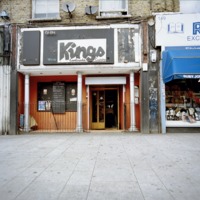
Kings
Letitia Kamayi: You Should Know Me
Artist’s Statement Kongo: You Should Know Me was my selfish way of learning more about my past, my ancestors through the images of my kinfolk. Unfortunately, the archive institutions I approached all asked for paperwork I could not supply; money I could not pay and questions I did not understand how to answer.
Only one missionary based in Ghent; the Sisters of Charity of Jesus and Mary, opened its doors and visual records to me and through them I was able to see a small percentage of the Congolese story before me. Though happy to have this access, I was not too overjoyed by everything I saw. There was a host of missing stories not recorded, stories that my family and friends families experienced. Chapters and verses missing from the identity of the Congolese narrative. Thus Kongo: You Should Know Me evolved to Kongo Archives.
Kongo Archives is extremely personal to me not merely because I am Congolese but also because there is a lot about my country I do not know and am searching for. I believe it is also something desperately needed, especially as our country’s political structure hangs in the global balance.
It’s a necessity even!
Culture; traditions; customs; language and pretty much everything has always been passed down orally through the stories in African customs, and now too many of those who did the passing down are fast passing away, taking with them all our history and rightful heritage. Taking away my rightful heritage, my story, my future and connection to a national identity.
It is a cliché to say, however Kongo Archives gives a voice to every Congolese person, travelling further than just those within the confines of the project. The archives is the stories of the past, the present and a storage unit where future stories can be placed when they become part of our inevitable past.
It [Kongo Archives] is here to topple the power structures of the single story of Congolese identity, working to reform the world’s understanding of, and have embedded notions questioned of a people whose stories and lives were second to the arrival of their colonial history and identity killers.
Bringing light to the stories which humanise the “so-called beasts from the dark continent” which continues till this day to suffer from decades of war and conflict whilst also being the wealthiest in natural minerals; culture and fight for peace one day.
Being Congolese I see our hidden presence in the “strangest” places, though this should not be a “strange” sight, this is the importance which representation brings! Change to people’s (and my own) opinions and views of those they are not well informed about. Kongo Archives will bring light to the multilayers of the Congolese people both residing in and out of The Motherland. It is important to have this representation to solidify the very absent Congolese presence outside of the Democratic Republic of Congo, in places such as London; Paris and Belgium as a positive display of unity; positive contribution and patriotism.
Kongo Archives aims to bring the Congolese heritage full circle through exposing the parts of our (Congolese) past and current state the world has and continues to fail to reveal. Breaking down the stereotypes of the poorest; “most dangerous place on earth to be a woman” to a country with a vast potential of peace; unconditional source of love and fight given the chance for change within its power structures.
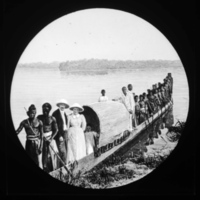
Christian Missionaries
A Christian missionary party crossing the Aruwimi river in the Aruwimi Welle zone of the Belgian Congo. This image (Neg. 102) formed part of the Harris Lantern Slide Collection. Under King Leopold II the Congo Free State used mass forced labour to extract rubber from the jungle for the European market. As consumer demand grew King Leopold II's private army - the Force Publique - used violent means to coerce the population into meeting quotas, including murder, mutilation, rape, village burning, starvation and hostage taking. Alice Seeley Harris and her husband Reverend John H. Harris were missionaries in the Congo Free State from the late 1890s. Alice produced a collection of images documenting the horrific abuses of the African rubber labourers. Her photographs are considered to be an important development in the history of humanitarian campaigning. The images were used in a number of publications. The Harrises also used the photographs to develop the Congo Atrocity Lantern Lecture which toured Britain and the the USA raising awareness of the issue of colonial abuses under King Leopold II's regime. Source: Antislavery International and Panos Pictures.
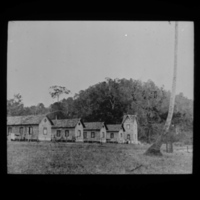
European-Style Houses
Unknown. This image formed part of the Harris Lantern Slide Collection. Under King Leopold II the Congo Free State used mass forced labour to extract rubber from the jungle for the European market. As consumer demand grew King Leopold II's private army - the Force Publique - used violent means to coerce the population into meeting quotas, including murder, mutilation, rape, village burning, starvation and hostage taking. Alice Seeley Harris and her husband Reverend John H. Harris were missionaries in the Congo Free State from the late 1890s. Alice produced a collection of images documenting the horrific abuses of the African rubber labourers. Her photographs are considered to be an important development in the history of humanitarian campaigning. The images were used in a number of publications. The Harrises also used the photographs to develop the Congo Atrocity Lantern Lecture which toured Britain and the the USA raising awareness of the issue of colonial abuses under King Leopold II's regime. Source: Antislavery International.
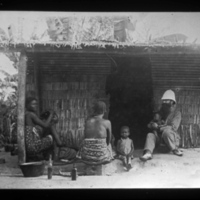
Missionary and African Women
Unknown. This image formed part of the Harris Lantern Slide Collection and was used in the Harris Lantern Lecture No 2. Under King Leopold II the Congo Free State used mass forced labour to extract rubber from the jungle for the European market. As consumer demand grew King Leopold II's private army - the Force Publique - used violent means to coerce the population into meeting quotas, including murder, mutilation, rape, village burning, starvation and hostage taking. Alice Seeley Harris and her husband Reverend John H. Harris were missionaries in the Congo Free State from the late 1890s. Alice produced a collection of images documenting the horrific abuses of the African rubber labourers. Her photographs are considered to be an important development in the history of humanitarian campaigning. The images were used in a number of publications. The Harrises also used the photographs to develop the Congo Atrocity Lantern Lecture which toured Britain and the the USA raising awareness of the issue of colonial abuses under King Leopold II's regime. Source: Antislavery International.
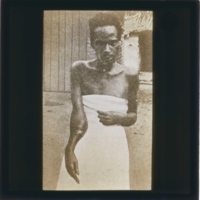
Photo of African Man, taken by W.D. Armstrong
Unknown. This photograph was taken by W. D. Armstrong.This image formed part of the Harris Lantern Slide Collection. Under King Leopold II the Congo Free State used mass forced labour to extract rubber from the jungle for the European market. As consumer demand grew King Leopold II's private army - the Force Publique - used violent means to coerce the population into meeting quotas, including murder, mutilation, rape, village burning, starvation and hostage taking. Alice Seeley Harris and her husband Reverend John H. Harris were missionaries in the Congo Free State from the late 1890s. Alice produced a collection of images documenting the horrific abuses of the African rubber labourers. Her photographs are considered to be an important development in the history of humanitarian campaigning. The images were used in a number of publications. The Harrises also used the photographs to develop the Congo Atrocity Lantern Lecture which toured Britain and the the USA raising awareness of the issue of colonial abuses under King Leopold II's regime.Source: Antislavery International.
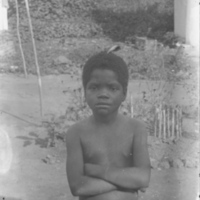
African Child
African child. This image formed part of the Harris Lantern Slide Collection. Under King Leopold II the Congo Free State used mass forced labour to extract rubber from the jungle for the European market. As consumer demand grew King Leopold II's private army - the Force Publique - used violent means to coerce the population into meeting quotas, including murder, mutilation, rape, village burning, starvation and hostage taking. Alice Seeley Harris and her husband Reverend John H. Harris were missionaries in the Congo Free State from the late 1890s. Alice produced a collection of images documenting the horrific abuses of the African rubber labourers. Her photographs are considered to be an important development in the history of humanitarian campaigning. The images were used in a number of publications. The Harrises also used the photographs to develop the Congo Atrocity Lantern Lecture which toured Britain and the the USA raising awareness of the issue of colonial abuses under King Leopold II's regime. Source: Antislavery International.
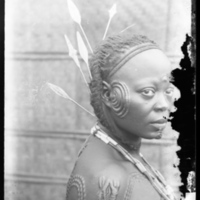
Young African Woman
Two descriptions exist for this image. The first is taken from the original photograph held at the Bodleian Library in Oxford. It reads 'An Ikelemba woman with tribal mark.' The second is taken from Antislavery International website's and reads 'Ngombe woman from the Bangalla region of the Upper Congo. The face cicatrisation is called 'the rasp'. Cicatrisation was a common practice in this region. See John H. Harris, Dawn in Darkest Africa (London: Smith, Elder & Co, 1912).' This photograph formed part of the Harris Lantern Slide Collection and was used in the Harris Lecture No.2. This image formed part of the Harris Lantern Slide Collection. Under King Leopold II the Congo Free State used mass forced labour to extract rubber from the jungle for the European market. As consumer demand grew King Leopold II's private army - the Force Publique - used violent means to coerce the population into meeting quotas, including murder, mutilation, rape, village burning, starvation and hostage taking. Alice Seeley Harris and her husband Reverend John H. Harris were missionaries in the Congo Free State from the late 1890s. Alice produced a collection of images documenting the horrific abuses of the African rubber labourers. Her photographs are considered to be an important development in the history of humanitarian campaigning. The images were used in a number of publications. The Harrises also used the photographs to develop the Congo Atrocity Lantern Lecture which toured Britain and the the USA raising awareness of the issue of colonial abuses under King Leopold II's regime. Source: Antislavery International.
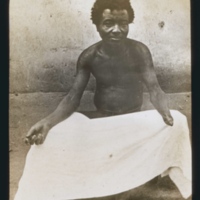
Young Congolese Man
Two differing descriptions of this photograph exist. The Harrises described him as Epondo injured by wild boar and questioned by Roger Casement. Secondly in the Special Congo supplement to the West African Mail the photograph is described as Isekausa whose hand was chopped off by Ikombi. This image formed part of the Harris Lantern Slide Collection and was used in the Harris Lecture No.3. Under King Leopold II the Congo Free State used mass forced labour to extract rubber from the jungle for the European market. As consumer demand grew King Leopold II's private army - the Force Publique - used violent means to coerce the population into meeting quotas, including murder, mutilation, rape, village burning, starvation and hostage taking. Alice Seeley Harris and her husband Reverend John H. Harris were missionaries in the Congo Free State from the late 1890s. Alice produced a collection of images documenting the horrific abuses of the African rubber labourers. Her photographs are considered to be an important development in the history of humanitarian campaigning. The images were used in a number of publications. The Harrises also used the photographs to develop the Congo Atrocity Lantern Lecture which toured Britain and the the USA raising awareness of the issue of colonial abuses under King Leopold II's regime. Source: Antislavery International.
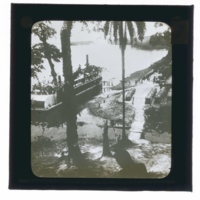
Steamship and River
Unknown. This image formed part of the Harris Lantern Slide Collection. Under King Leopold II the Congo Free State used mass forced labour to extract rubber from the jungle for the European market. As consumer demand grew King Leopold II's private army - the Force Publique - used violent means to coerce the population into meeting quotas, including murder, mutilation, rape, village burning, starvation and hostage taking. Alice Seeley Harris and her husband Reverend John H. Harris were missionaries in the Congo Free State from the late 1890s. Alice produced a collection of images documenting the horrific abuses of the African rubber labourers. Her photographs are considered to be an important development in the history of humanitarian campaigning. The images were used in a number of publications. The Harrises also used the photographs to develop the Congo Atrocity Lantern Lecture which toured Britain and the the USA raising awareness of the issue of colonial abuses under King Leopold II's regime. Source: Antislavery International.
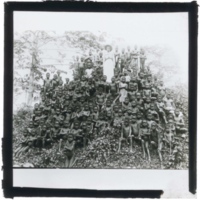
Alice Seeley Harris with Children
Alice Seeley Harris with a large group of Congolese children.This image formed part of the Harris Lantern Slide Collection. Under King Leopold II the Congo Free State used mass forced labour to extract rubber from the jungle for the European market. As consumer demand grew King Leopold II's private army - the Force Publique - used violent means to coerce the population into meeting quotas, including murder, mutilation, rape, village burning, starvation and hostage taking. Alice Seeley Harris and her husband Reverend John H. Harris were missionaries in the Congo Free State from the late 1890s. Alice produced a collection of images documenting the horrific abuses of the African rubber labourers. Her photographs are considered to be an important development in the history of humanitarian campaigning. The images were used in a number of publications. The Harrises also used the photographs to develop the Congo Atrocity Lantern Lecture which toured Britain and the the USA raising awareness of the issue of colonial abuses under King Leopold II's regime. Source: Antislavery International and Panos Pictures.
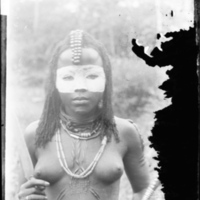
African Woman Described as a Witch
African woman described as a 'Witch at Euli, Ikelemba'. This image formed part of the Harris Lantern Slide Collection. Under King Leopold II the Congo Free State used mass forced labour to extract rubber from the jungle for the European market. As consumer demand grew King Leopold II's private army - the Force Publique - used violent means to coerce the population into meeting quotas, including murder, mutilation, rape, village burning, starvation and hostage taking. Alice Seeley Harris and her husband Reverend John H. Harris were missionaries in the Congo Free State from the late 1890s. Alice produced a collection of images documenting the horrific abuses of the African rubber labourers. Her photographs are considered to be an important development in the history of humanitarian campaigning. The images were used in a number of publications. The Harrises also used the photographs to develop the Congo Atrocity Lantern Lecture which toured Britain and the the USA raising awareness of the issue of colonial abuses under King Leopold II's regime. Source: Antislavery International.
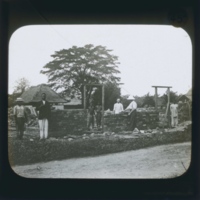
Chapel Built by British Missionaries
The chapel being built used free labour. British missionaries in Belgian Congo. This image formed part of the Harris Lantern Slide Collection. Under King Leopold II the Congo Free State used mass forced labour to extract rubber from the jungle for the European market. As consumer demand grew King Leopold II's private army - the Force Publique - used violent means to coerce the population into meeting quotas, including murder, mutilation, rape, village burning, starvation and hostage taking. Alice Seeley Harris and her husband Reverend John H. Harris were missionaries in the Congo Free State from the late 1890s. Alice produced a collection of images documenting the horrific abuses of the African rubber labourers. Her photographs are considered to be an important development in the history of humanitarian campaigning. The images were used in a number of publications. The Harrises also used the photographs to develop the Congo Atrocity Lantern Lecture which toured Britain and the the USA raising awareness of the issue of colonial abuses under King Leopold II's regime. Source: Antislavery International.
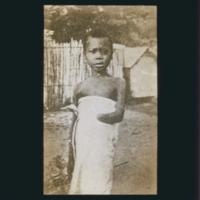
Lokota of Mpelengi
The child in the photo was called Lokota of Mpelengi and was mutilated by soldiers in the course of a raid from ABIR militia (Anglo-Belgian India Rubber Company) in the Belgian Congo in 1903. Lokota was brought to see Roger Casement on 7 September 1903 at the Mission at Bonginda. He was photographed by W. D. Armstrong. Lokota was a toddler when he was mutilated. The village Mpelengi (about three miles away from the Mission) was attaked when the people failed to meet their rubber quota. Four sentries - Mokwolo, Ebomi, Mokuba, Bomolo - killed the chief Eliba. The villagers fled but Lokota fell and was mutilated by Mokwolo on being caught. This photograph was the first Congo atrocity image to be published by in the missionary magazine Regions Beyond in January 1904. This photograph (Neg. 119) formed part of the Harris Lantern Slide Collection. Under King Leopold II the Congo Free State used mass forced labour to extract rubber from the jungle for the European market. As consumer demand grew King Leopold II's private army - the Force Publique - used violent means to coerce the population into meeting quotas, including murder, mutilation, rape, village burning, starvation and hostage taking. Alice Seeley Harris and her husband Reverend John H. Harris were missionaries in the Congo Free State from the late 1890s. Alice produced a collection of images documenting the horrific abuses of the African rubber labourers. Her photographs are considered to be an important development in the history of humanitarian campaigning. The images were used in a number of publications. The Harrises also used the photographs to develop the Congo Atrocity Lantern Lecture which toured Britain and the the USA raising awareness of the issue of colonial abuses under King Leopold II's regime. Source: Antislavery International and Panos Pictures. A account of Lokota's experiences can be read in E. D. Morel
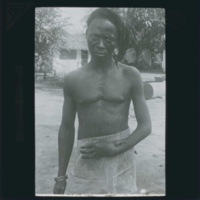
Lomboto of Bolumboloko
Lomboto of Bolumboloko shot in the wrist and hand by ABIR Anglo-Belgian India Rubber Company sentries. Information taken from the Special Congo supplement to the West African Mail Sept 1905. This image formed part of the Harris Lantern Slide Collection. Under King Leopold II the Congo Free State used mass forced labour to extract rubber from the jungle for the European market. As consumer demand grew King Leopold II's private army - the Force Publique - used violent means to coerce the population into meeting quotas, including murder, mutilation, rape, village burning, starvation and hostage taking. Alice Seeley Harris and her husband Reverend John H. Harris were missionaries in the Congo Free State from the late 1890s. Alice produced a collection of images documenting the horrific abuses of the African rubber labourers. Her photographs are considered to be an important development in the history of humanitarian campaigning. The images were used in a number of publications. The Harrises also used the photographs to develop the Congo Atrocity Lantern Lecture which toured Britain and the the USA raising awareness of the issue of colonial abuses under King Leopold II's regime. Source: Antislavery International. This is possibly the same Lomboto whose experiences were documented in Evidence laid before the Congo Commission of Inquiry at Bwembu, Bolobo, Lulanga, Baringa, Bongandanga, Ikau, Bonginda, and Monsembe. Together with a summary of events (and documents connected therewith) on the A.B.I.R. concession since the Commission visited that territory (Liverpool, J. Richardson & Sons,1905), pp. 23-24.